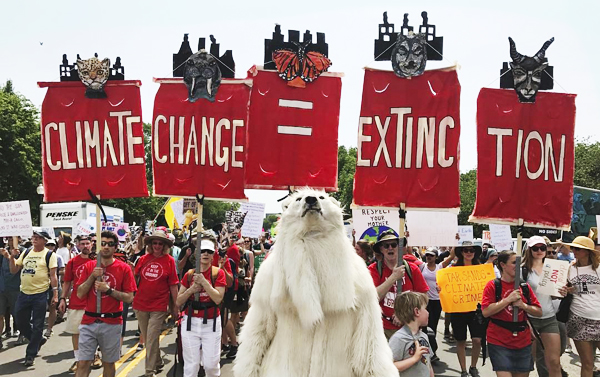
Earth Lovers,
So that 20% to 45% of all life will NOT die by 2028, I hope you will join me [and other climate activists] in a promise to take big climate actions every day to help stop the mega wildfires, heatwaves, floods and other climate change monsters that are killing our sweet biosphere.
We may have six months [or six weeks] to rescue our sweet mother Earth from this dying so your help is crucial. Even though millions of people are already taking big climate actions to stop this dying, we need you to join us too. [Big thaaank youuu if you are already on team Earth!!][Months To Save Earth]
I hope you will join me [Stele Ely] in a promise to ::
+ Dedicate 44% of your time [19.4 hours per week] with teams and projects that slow down the climate change monster heatwaves, floods, fires and storms. [EarthTime44]
+ Invest 44%* of your net income and/or relevant assets in organizations and projects that slow down the climate change triggered terrorism, violence, political instability and inflation. (*sliding scale) [EarthMoney44]
+ EarthDare 14 people every day to promise to take one of the Big Climate Actions that you suggest. Offer them a victory dance, song, art or some other cool thing if they promise. [EarthDare]
+ Eat Plant-Based. It is more important to prevent animal suffering, rather than sit to contemplate the evils of the universe praying in the company of priests. [GoVeganPlease]
+ So that 6% to 12% of all multi-cellular life will not die by 2026.
+ So that 10% to 25% of all multi-cellular life will not die by 2027.
+ So that 20% to 45% of all multi-cellular life will not die by 2028.
+ So that 35% to 70% of all multi-cellular life will not die by 2029.
[As a percentage of Earth’s 2023 total multi-cellular biomass.]
+ So that Earth will not be 2.0 to 2.4 Celsius too hot by 2026
[4.1 to 4.9 Fahrenheit]
+ So that Earth will not be 2.2 to 3.5 Celsius too hot by 2027.
[4.3 to 6.3 Fahrenheit]
+ So that Earth will not be 2.5 to 4.5 Celsius too hot by 2028.
[4.7 to 8.1 Fahrenheit]
+ So that Earth will not be 2.8 to 6.0 Celsius too hot by 2029.
[5.0 to 10.8 Fahrenheit]
[As an average global temperature rise above the 1750 baseline.]
+ So that there will not be 20% to 30% more climate disasters by 2026.
+ So that there will not be 30% to 50% more climate disasters by 2027.
[As a multiple of the 2021 and 2022 average number climate change disasters.]
+ So that 3 to 6 billion people will not die by 2040.
These guesstimates are based on my interpretation of non-peer-reviewed climate opinion articles, and peer-reviewed scientific papers, and IPCC reports, and temperature and climate related data and graphs, plus my own non-scientific observations. Many of my sources are cited below.
For life and love, Stele Ely January 3, 2024
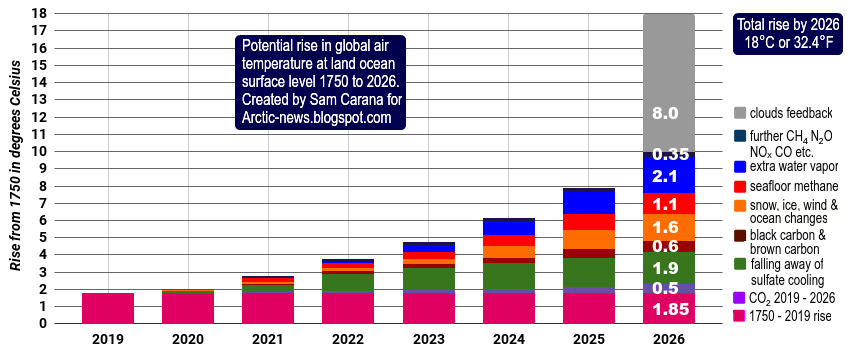
About These Guesstimates
My guesstimates include a greater than 20% chance that the inverse negative outcomes might occur if we do not take big climate actions and major ecological actions now. However, even if the inverse of my guesstimates have only a 0.1% chance of these disastrous mass losses of Earth’s life, I would still be fighting hard to reduce even that 1 in a thousand chance of such a sweeping loss of life and love.
The inverse of the above guesstimates were inferred and based on the sources that are cited below and others not yet cited. More recent sources may not be cited because I use most of my time to ask people, businesses and office holders to::
+ Dedicate 44% of their time [19.4 hours per week] and 44%* of their net income or relevant assets in organizations and projects that are working to stop this climate emergency.
+ EarthDare 14 peeps and bizs a day to take big climate actions.
+ Encouraging and showing others how to eat plant-based and vegan.
I promise to continue to take big climate actions and help others to do the same so we can change those guesstimates. And I am thrilled to know that every time I choose to use very little fossil fuels, live eco logically, or make my work or the world more sustainable, this biosphere gets to live a little longer, and we get to have more fun.
Whether or not you agree with my guesstimates, join me and others in these promises if you think that our exquisite Earth is in a climate emergency and is seriously imperiled.
To thank you for your promise, feel free to contact me so I can sing you a song over live video or send you a signed XOEarth Award.
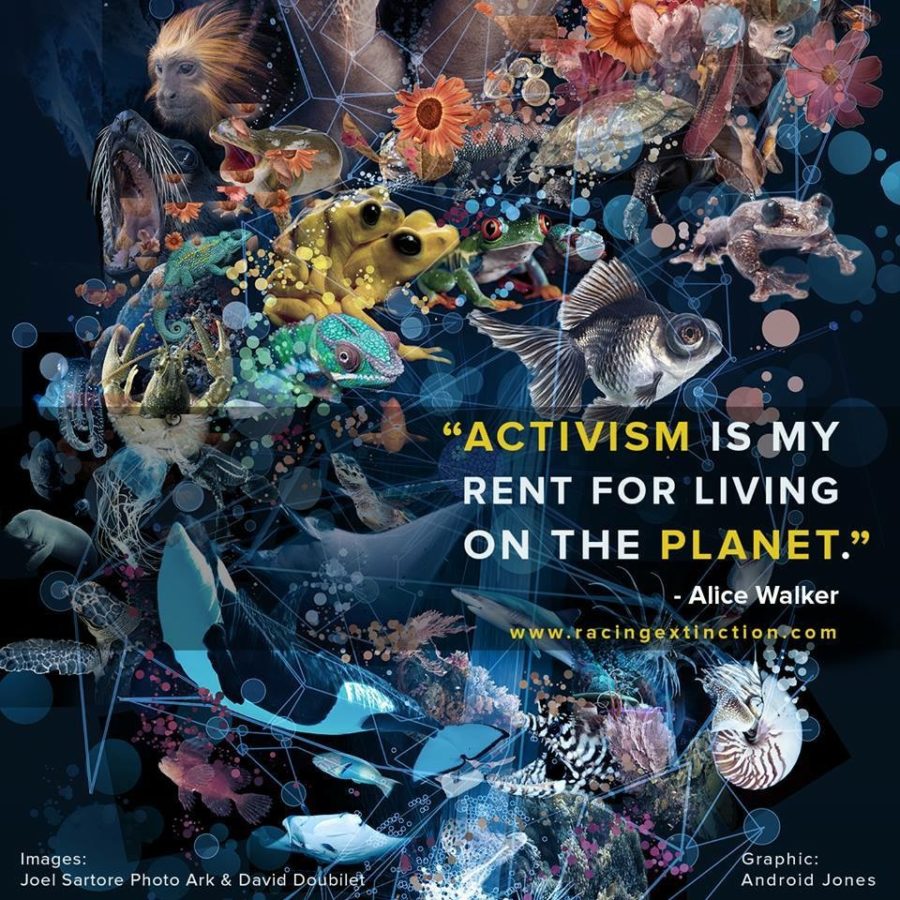
Sources / Assessments / My Comments
Some of my [Stele Ely] comments are tagged with a [~S].+ Arctic-News.blogspot.com has articles and timelines for possible global temperature increases and human extinction. Arctic-News.blogspot.com has over 24 scientists and some non-scientists who are listed as the main contributors. None of the listed contributors are substantially disputing the possible human extinction timelines that Sam Carana and the other main writers have proposed. There is a Debate and Controversy page for that purpose. Sam Carana is the primary writer for Arctic-News.blogspot.
[The percentage of multi-cellular biosphere die-off that would result in human extinction was not precisely stated in this source, as far as I have seen. ~S]
[It seems very probable to me, Stele, that it would take a very large die-off of multi-cellular life on our biosphere to result in total human extinction. ~S]
+ Roger Hallams of Extinction Rebellion in a BBC HARDtalk interview has stated that 6 billion people could die by 2100 if we do not slow down climate change. That assertion is supported by David Spratt at Climate Code Red in the article “At 4°C of warming, would a billion people survive? What scientists say.”.
+ Climate Shock authors Gernot Wagner and Martin L. Weitzman state in table 3.1 that there is a 1.2% chance of a >6 C warming potential at 500ppm CO2e. gwagner.com/books/climate-shock/
+ In January 2019 we were at about 410ppm CO2 and about 495ppm CO2e. A 1.2% chance of >6 C is too high for me to feel cushy. Most assessments say that at >6 C our planet would be largely uninhabitable.
+ The Climate Shock table also says there is a 3% chance of a >6 C warming potential at 550ppm CO2e. That Climate Shock table also says there is a 5% chance of a >6 C warming potential at 600ppm CO2e. That Climate Shock table says there is a 10% chance of a >6 C warming potential at 700ppm CO2e. Wow!
+ Carbon Dioxide Is Rising at Record Rates / Brian Kahn / climatecentral.org The annual growth of 3 parts per million in 2016 is the slightest shade below the jump in 2015 of 3.03 ppm. Both years mark the first time carbon dioxide has risen more than 3 ppm in a single year in ESRL’s 59 years of monitoring.
+ A rise of 18°C or 32.4°F by 2026? / Sam Carana / arctic-news.blogspot.com/2019/02/a-rise-of-18c-or-324f-by-2026.html A catastrophe of unimaginable proportions is unfolding. Life is disappearing from Earth and all life could be gone within one decade. Study after study is showing the size of the threat, yet many people seem out to hide what we’re facing. In the Arctic alone, four tipping points look set to be crossed within a few years: 1] Loss of the Arctic sea ice’s ability to act as a buffer to absorb incoming ocean heat. 2] Loss of Arctic sea ice’s ability to reflect sunlight back into space (albedo). 3] Destabilization of sediments at the seafloor of the Arctic Ocean. 4] Permafrost melt.
+ Maximum warming occurs about one decade after a carbon dioxide emission / Katharine L Ricke and Ken Caldeira / via iopscience.iop.org Using conjoined results of carbon-cycle and physical-climate model intercomparison projects (Taylor et al 2012, Joos et al 2013), we find the median time between an emission and maximum warming is 10.1 years, with a 90% probability range of 6.6–30.7 years.
+ The time lag between a carbon dioxide emission and maximum warming increases with the size of the emission / Kirsten Zickfeld1 and Tyler Herrington Our results indicate that as CO2 continues to accumulate in the atmosphere, the full warming effect of an emission may take several decades, if not centuries to emerge. A large fraction of the warming, however, will be realized relatively quickly (93% of the peak warming is realized 10 years after the emissions for the 1000 PgC pulse). This implies that the warming commitment from past CO2 emissions is small, and that future warming will largely be determined by current and future CO2 emissions. Each additional CO2 emission will contribute to warming that will persist almost indefinitely. Thus, emission reductions implemented today will equally benefit current and future generations.
+ Climate Shock book and/or presentations / Gernot Wagner and Martin L. Weitzman / gwagner.com “[There is] about a 10 percent chance of eventual temperatures exceeding 6°C (11°F) [at greater than 700ppm CO2e] unless the world acts much more decisively than it has.” “…500 ppm [CO2e] [has] a chance of [>6 C] catastrophe [at] 1.2 percent.” Fat Tails chapter.
+ Global Extinction Within 18 – 34 Months / Malcolm Light / Arctic-News.Blogspot.com Humanity is facing the final, western corporate capitalist, fossil fuel initiated, catastrophic Arctic methane hydrate destabilization and Permian style methane blowout – firestorm that will culminate in 1 to 4 years (2020 to 2023).
+ Will humans be extinct by 2026? / Sam Carana, et al / Arctic-News.Blogspot.com
+ Rapid climate change has happened before / PHYS.org . [5 C rise in global-average temperature 55 million years ago during a span of 13 years. ~S]
+ New Climate-Economic Thinking / The Institute for New Economic Thinking / Gernot Wagner and Martin L. Weitzman Instead of focusing on averages then, climate ought to be seen as a risk management problem. Some greenhouse gas concentration thresholds should simply not be crossed. The risks are too high.
+ oceanservice.noaa.gov : The Science of Abrupt Climate Change: Should we be worried? / Jeffrey Masters, Ph.D.”…As seen in Figure 1, the ice core record showed frequent sudden warmings and coolings of 15°F (8°C) or more. Many of these changes happened in less than 10 years. In one case 11,600 years ago, when Earth emerged from the final phase of the most recent ice age (an event called the Younger Dryas), the Greenland ice core data showed that a 15°F (8°C) warming occurred in less than a decade, accompanied by a doubling of snow accumulation in 3 years. Most of this doubling occurred in a single year.” oceanservice.noaa,gov/education/pd/ tidescurrents/effects/ climatechange_currents_lesson.html
+ Global-warming Armageddon? It may be more likely than you thought / Colin Goldblatt Author of a paper published online in the 28 July 2013 issue of Nature Geoscience, “The runaway greenhouse may be much easier to initiate than previously thought.”
+ CNN : On 6 degrees of climate change / John Sutter, CNN senior writer
+ Arctic Methane Monster I and II videos and articles / Jennifer Hynes .
+ Guy McPherson’s timeline for possible human extinction stated in his Climate Change Summary and Update, articles and presentations.
Guy McPherson’s near term human extinction assessment may be wrong – and we will be slap happy if and when he is proven wrong.
[Note: The percentage of multi-cellular biosphere die-off that would result in human extinction was not precisely stated in this source, as far as I have seen.]
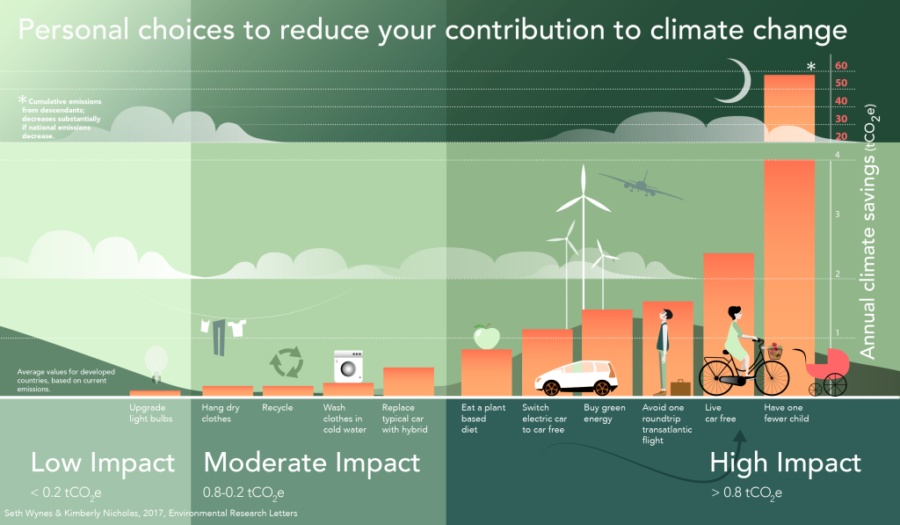
More Assessments / Resources
+ “Let us consider, in that context, the prospects for warming well in excess of what we might term “dangerous” (typically considered to be at least 2C or 3.6F warming of the planet).” / Michael E Mann / huffingtonpost.com “How likely, for example, are we to experience a catastrophic 6C [11F] warming of the globe, if we allow greenhouse gas concentrations to reach double their pre-industrial levels (something we’re on course to do by the middle of this century given business-as-usual burning of fossil fuels)?
Well, the mean or average warming that is predicted by models in that scenario is about 3C, and the standard deviation about 1.5C. So the positive tail, defined as the +2 sigma limit, is about 6C of warming. As shown by Wagner and Weitzman (see figure below), the likelihood of exceeding that amount of warming isn’t 2% as we would expect for a bell-curve distribution. It’s closer to 10%!”
+ National Academy of Sciences [NAS] : Abrupt Climate Change Inevitable Surprises (2002) by 29 scientists and writers.
+ United Nations Environment Programme (mid 2017): 3.2 C by 2100. / wedocs.unep.org The 3.2 C May be based on assumption of countries meeting the Paris Agreement. The report states, “Implementation of the unconditional NDCs and comparable action afterwards is consistent with a temperature increase of about 3.2°C by 2100 relative to pre-industrial levels. Full implementation of the conditional NDCs would lower the projection by about 0.2°C.” [Nationally Determined Contributions (NDCs) form the foundation of the Paris Agreement.]
+ Year 2100 Projections: Based on climate action pledges of UN member countries. / ClimateInteractive.org + www.co2.earth/2100-projections“…Confirmed Proposals As of March 1, 2011, Temperature Rise (2100)4.0°C, 800 ppm CO2, 1060 ppm CO2e, 103.40 Gt…”
+ The Climate Scoreboard shows the progress that national plans submitted to the UN climate negotiations will make in mitigating climate change. / ClimateInteractive.org (2018) Our analysis shows that the national contributions to date, with no further progress post-pledge period, result in expected warming in 2100 of 3.3°C (with a range of uncertainty of 1.9 – 4.4°C)
+ Hadley Centre for Meteorological Research (October 2009): 4 C by 2060 / www.theguardian.com
+ Late in 2008, Hadley Center’s head of climate change predictions Dr. Vicky Pope calls for a worst-case outcome of more than 5 C by 2100. / Joe Romm / Grist.org, “right now even Hadley [Centre] understands it [> 5 C] is better described as the ‘business-as-usual’ case.”
+ Intergovernmental Panel on Climate Change (late 2007): >1.8 C by 2100 (up to 4.5 C, depending upon emissions scenarios) [NEEDS UPDATED]
+ ClimateInteractive.org (2017) + www.co2.earth Based on climate action pledges of UN member countries Based on climate action pledges of UN member countries 4.0 C by 2100.
+ International Energy Agency (2017) / www.iea.org: projection is up 4°C by the end of this century with business as usual.
+ Climate change occurring ten times faster than at any time in past 65 million years / Noah Diffenbaugh and Chris Field / Stanford Woods Institute for the Environment / www.sciencedaily.com …the researchers note that, with continued emissions of greenhouse gases at the high end of the scenarios, annual temperatures over North America, Europe and East Asia will increase 2-4 degrees C by 2046-2065.
+ The Potential For Huge Abrupt Temperature Rise / Sam Carana, et al / Arctic-News.blogspot.com The image below shows that temperatures typically moved up and down by roughly 10°C (ten degrees Celsius, or eighteen degrees Fahrenheit, i.e. 18°F) between a glacial and interglacial phase of the ice ages, suggesting that a 100 ppm rise of carbon dioxide and 300 ppb rise of methane go hand in hand with a 10°C temperature rise. In other words, it looks like high levels of greenhouse gases in the atmosphere have already locked us in for a future temperature rise of 10°C.
+ World Scientists’ Warning to Humanity: A Second Notice : More than 15,000 signatories / academic.oup.com/bioscience stating, “To prevent widespread misery and catastrophic biodiversity loss, humanity must practice a more environmentally sustainable alternative to business as usual. This prescription was well articulated by the world’s leading scientists 25 years ago, but in most respects, we have not heeded their warning. Soon it will be too late to shift course away from our failing trajectory, and time is running out. We must recognize, in our day-to-day lives and in our governing institutions, that Earth with all its life is our only home.
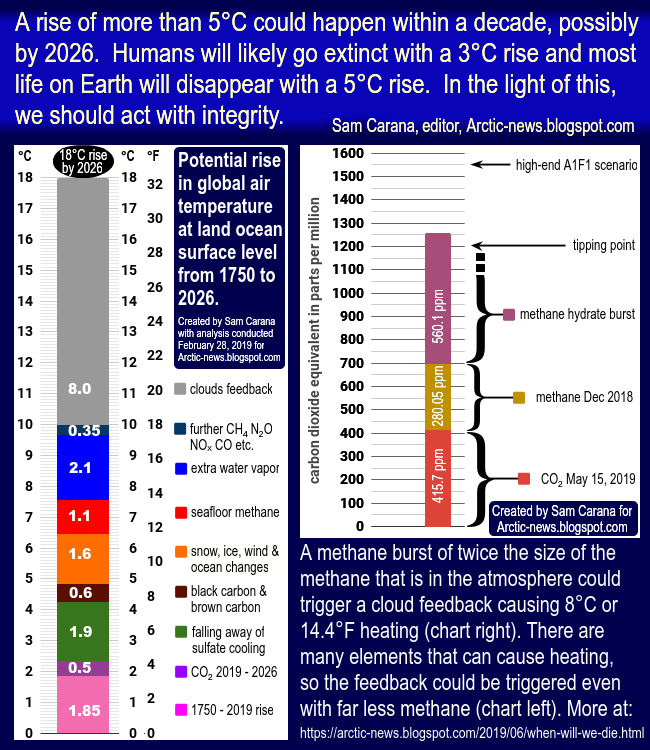
Yet More Resources / Articles
+ NASA: Goddard Institute for Space Studies: Surface Temperature Analysis Graphs / data.giss.nasa.gov
+ NASA: Climate change: How do we know? / climate.nasa.gov/evidence
+ THE NOAA ANNUAL GREENHOUSE GAS INDEX (AGGI) See CO2-eq (ppm) chart / www.esrl.noaa.gov/gmd/ccgg/trends/global.htmlThe annual CO2 increase from 1 Jan 2016 to 1 Jan 2017 was 2.9 ± 0.1 ppm, and then, 1 Jan 2017 to 1 Jan 2018 was 2.1 ± 0.1 ppm
+ Runaway_climate_change / en.wikipedia.org The scientific consensus in the IPCC Fourth Assessment Report is that “Anthropogenic warming could lead to some effects that are abrupt or irreversible, depending upon the rate and magnitude of the climate change.”
+ National Academy of Sciences [NAS] : Abrupt Climate Change Inevitable Surprises / www.ucsusa.org “…scientists have found that changes in climate have occurred quickly in the past—over the course of a decade. An example of an abrupt climate change event is the Younger Dryas (~12,000 years ago), a period of abrupt cooling that interrupted a general warming trend as Earth emerged from the last Ice Age. During the Younger Dryas period, average summertime temperatures in New England cooled by about 5-7°F (3-4°C).
+ Read Stele’s How Many Months To Save Earth post. #HowMany #MonthsToSaveEarth

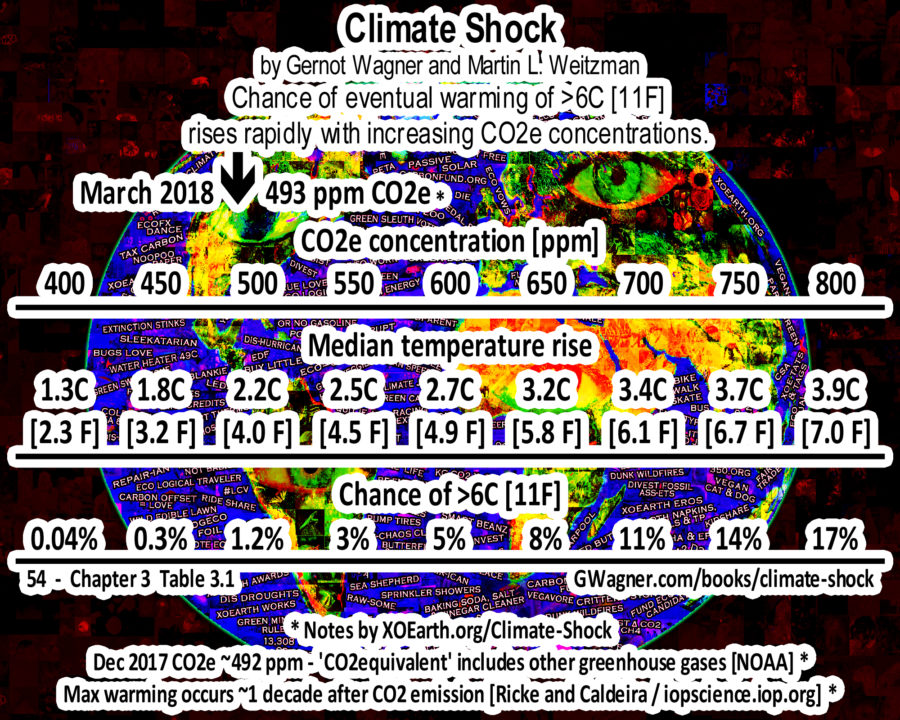 via Climate Shock / Gernot Wagner & Martin L. Weitzman
… The scariest bit is just how fast the chance of eventual temperatures exceeding 6°C (11°F) goes up. …
We are at about 492ppm CO2e in February 2018 – so the 500ppm CO2e column is relevant now. [Embiggen table]
via Climate Shock / Gernot Wagner & Martin L. Weitzman
… The scariest bit is just how fast the chance of eventual temperatures exceeding 6°C (11°F) goes up. …
We are at about 492ppm CO2e in February 2018 – so the 500ppm CO2e column is relevant now. [Embiggen table]
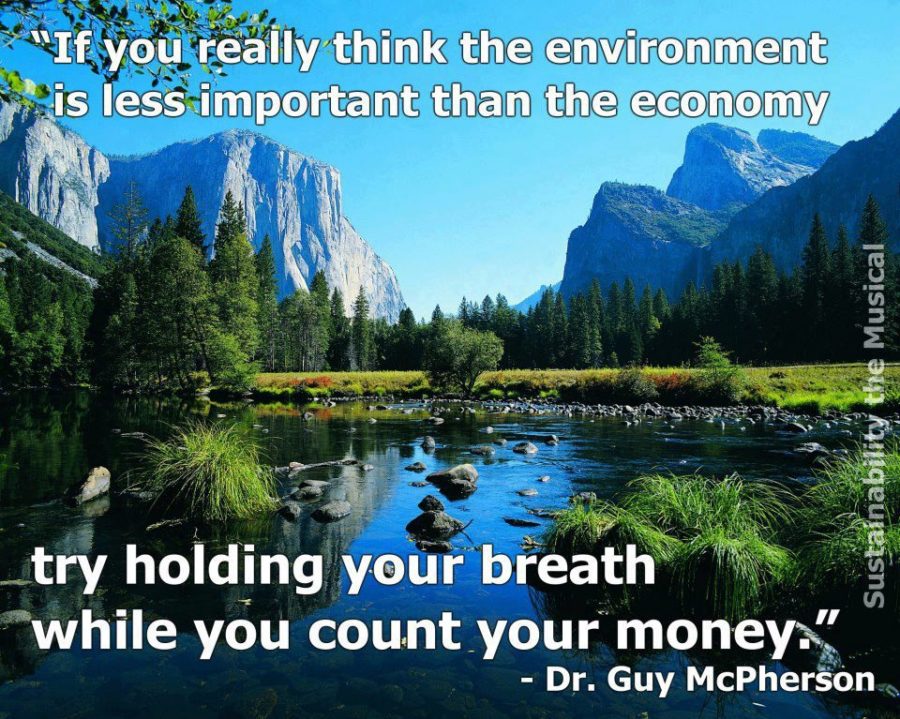
Artists:: We need a vid, art and dance for the Guesstimate.
Musicians:: Write and record your Guesstimate version and we will promote it here.
Fans:: Share this page and/or sponsor a Guesstimate song.



Leave a Reply
You must be logged in to post a comment.